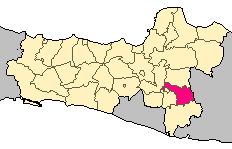
Central Java is a province of Indonesia, located in the middle of the island of Java. Its administrative capital is Semarang. It is bordered by West Java in the west, the Indian Ocean and the Special Region of Yogyakarta in the south, East Java in the east, and the Java Sea in the north. It has a total area of 32,800.69 km2, with a population of 36,516,035 at the 2020 Census making it the third-most populous province in both Java and Indonesia after West Java and East Java. The official estimate as at mid 2021 was 36,742,501. The province also includes the island of Nusakambangan in the south, and the Karimun Jawa Islands in the Java Sea.

The Sardar Sarovar Dam is a concrete gravity dam built on the Narmada River in Navagam near the town of Kevadiya, Narmada District, in the state of Gujarat, India. The dam was constructed to provide water and electricity to four Indian states: Gujarat, Madhya Pradesh, Maharashtra, and Rajasthan.

The Subarnarekha River flows through the Indian states of Jharkhand, West Bengal and Odisha.

Boyolali is a regency in the eastern part of Central Java province in Indonesia. It covers an area of 1,015.10 km2, and had a population of 930,531 at the 2010 census and 1,062,713 at the 2020 census.
Tawa Reservoir is a reservoir on the Tawa River in central India. It is located in Itarsi of Narmadapuram District of Madhya Pradesh state, above Betul district. The reservoir was formed by the construction of the Tawa Dam, which began in 1958 and was completed in 1978. The dam provides for irrigation to several thousand hectares of farming land in Narmadapuram and Harda districts. It is also a big tourist attraction during the monsoon months. A cruise boat service has been started by the tourism department for visitors to the dam and reservoir.

Damodar Valley Corporation (DVC) is a government-owned power generator which operates in the Damodar River area of West Bengal and Jharkhand states of India. The statutory corporation operates both thermal power stations and hydel power stations under the ownership of Ministry of Power, Government of India. DVC is headquartered in the Kolkata city of West Bengal, India.
Grobogan Regency is a regency located in northeastern part of the Central Java province in Indonesia.

Karanganyar Regency is a regency in the Indonesian province of Central Java. It covers an area of 773.79 km2 and had a population of 813,196 at the 2010 Census and 931,963 at the 2020 Census. Its capital is the town of Karanganyar.

Manyuchi Dam forms a reservoir on the Mwenezi River in southern Zimbabwe. It is located in the Mwenezi District. The building of the dam was financed by the Mwenezi Development Corporation. The dam was built to irrigate oil palm estates.
Rengali dam is a dam located in Odisha, India. It is constructed across the Brahmani River in Rengali village, located 70 km from Angul in Angul district.

The Bakolori Dam is in Sokoto State in northwest Nigeria. It was completed in 1978 and its reservoir filled by 1981. It is a major reservoir on the Sokoto River, a tributary of the Rima River, which in turn feeds the Niger River. Water from the dam supplies the Bakolori Irrigation Project.

The Jatigede Dam is an embankment dam on the Cimanuk River in Sumedang Regency, West Java, Indonesia. It is located 19 km (12 mi) east of the town of Sumedang. Construction on the dam began in 2008 and it was completed in 2015. The power station is expected to be commissioned in 2019. The primary purpose of the dam is irrigation but it will also provide for flood control, water supply and hydroelectric power generation. Water in the reservoir will be used to help irrigate 90,000 ha of farmland and the power station is expected to have a 110 MW capacity. The project has become controversial, primarily due to the relocation of people in the future reservoir zone.

The Kanjirapuzha Dam, a masonry earth dam built for providing irrigation to a Cultural Command Area (CCA) of 9,713 hectares, is located in the Palakkad district in the Indian state of Kerala. The reservoir, which has three islands within it, also has an established commercial fisheries development programme operated by the Fisheries Department.
Ci Tanduy is a river in the island of Java, Indonesia, about 270 km to the southeast of the capital Jakarta. It flows from West Java to Central Java province, exiting through the Bay of Citanduy to the Indian Ocean, forming a delta called "Muara Citanduy."

Gajah Mungkur Reservoir (Dam) is a water reservoir located at Pokohkidul in the Wonogiri Regency, Central Java, of Indonesia. It was constructed by redirecting the Bengawan Solo River, the longest in the Java Islands, which originates from The Gajah Mungkur Mountain. The maximum inundation area of Gajah Mungkur Reservoir is 8,800 hectares and covers the seven subdistricts of Wonogiri, Ngadirojo, Nguntoronadi, Baturetno, Giriwoyo, Eromoko, and Wuryantoro.

Kedungbanteng is a district located in the eastern part of Tegal Regency, Central Java, Indonesia. The Kedungbanteng district is 8 km drive from the center of regency, namely Slawi Town through southern of Pangkah district. The central government is located in the village of Kedungbanteng.
Mochamad Hasbi was an Indonesian army officer and politician who served as the Regent of Boyolali from 1984 until 1994 and the deputy speaker of the Central Java Regional People's Representative Council from 1999 until 2007.












